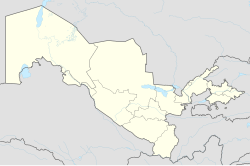Karakalpakia
Karakalpakiya | |
|---|---|
Urban-type settlement | |
| Coordinates: 44°46′00″N 56°12′00″E / 44.76667°N 56.20000°E | |
| Country | |
| Autonomous Republic | |
| District | Qońırat District |
| Population (2016) | |
| • Total | 4,500 |
| Time zone | UTC+5 (UZT) |
Karakalpakia (Karakalpak: Karakalpakiya) is an urban-type settlement of Qońırat district in the autonomous Republic of Karakalpakstan in Uzbekistan.[1] Its population was 3,013 people in 1989,[2] and 4,500 in 2016.[3]
Climate
[edit]Karakalpakia has a continental desert climate (Köppen: BWk),[4]
| Climate data for Karakalpakia (1991–2020) | |||||||||||||
|---|---|---|---|---|---|---|---|---|---|---|---|---|---|
| Month | Jan | Feb | Mar | Apr | May | Jun | Jul | Aug | Sep | Oct | Nov | Dec | Year |
| Mean daily maximum °C (°F) | −2.8 (27.0) |
−0.6 (30.9) |
8.7 (47.7) |
19.2 (66.6) |
27.1 (80.8) |
33.3 (91.9) |
35.5 (95.9) |
34.0 (93.2) |
26.4 (79.5) |
17.5 (63.5) |
6.3 (43.3) |
−0.6 (30.9) |
17.0 (62.6) |
| Daily mean °C (°F) | −6.5 (20.3) |
−5.2 (22.6) |
2.8 (37.0) |
12.2 (54.0) |
20.0 (68.0) |
26.0 (78.8) |
28.4 (83.1) |
26.4 (79.5) |
18.6 (65.5) |
10.1 (50.2) |
1.3 (34.3) |
−4.4 (24.1) |
10.8 (51.4) |
| Mean daily minimum °C (°F) | −9.8 (14.4) |
−9.1 (15.6) |
−1.8 (28.8) |
6.1 (43.0) |
12.9 (55.2) |
18.2 (64.8) |
20.7 (69.3) |
18.4 (65.1) |
11.2 (52.2) |
3.8 (38.8) |
−2.8 (27.0) |
−7.7 (18.1) |
5.0 (41.0) |
| Average precipitation mm (inches) | 15.3 (0.60) |
11.9 (0.47) |
19.2 (0.76) |
21.6 (0.85) |
16.4 (0.65) |
14.3 (0.56) |
8.1 (0.32) |
5.5 (0.22) |
4.5 (0.18) |
11.4 (0.45) |
17.1 (0.67) |
14.6 (0.57) |
159.9 (6.30) |
| Average precipitation days (≥ 1.0 mm) | 13 | 11 | 9 | 7 | 8 | 6 | 5 | 3 | 3 | 5 | 9 | 13 | 92 |
| Mean monthly sunshine hours | 95.8 | 130.8 | 184.4 | 231.1 | 305.6 | 346.5 | 356.7 | 341.0 | 280.0 | 223.1 | 125.7 | 86.3 | 2,707 |
| Source: NOAA[5] | |||||||||||||
References
[edit]- ^ "Classification system of territorial units of the Republic of Uzbekistan" (in Uzbek and Russian). The State Committee of the Republic of Uzbekistan on statistics. July 2020.
- ^ Population census-1989
- ^ Soliyev, A.S. Shaharlar geografiyasi [Geography of cities] (PDF) (in Uzbek). p. 147., listed as "Qoraqalpogʻistan"
- ^ "Table 1 Overview of the Köppen-Geiger climate classes including the defining criteria". Nature: Scientific Data.
- ^ "World Meteorological Organization Climate Normals for 1991-2020 — Karakalpakia". National Oceanic and Atmospheric Administration. Retrieved January 19, 2024.


Well, that’s interesting to know that Psilotum nudum are known as whisk ferns. Psilotum nudum is the commoner species of the two. While the P. flaccidum is a rare species and is found in the tropical islands. Both the species are usually epiphytic in habit and grow upon tree ferns. These species may also be terrestrial and grow in humus or in the crevices of the rocks.
View the detailed Guide of Psilotum nudum: Detailed Study Of Psilotum Nudum (Whisk Fern), Classification, Anatomy, Reproduction